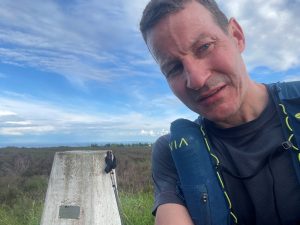The New Lyke Wake Club
A Northern Stealth Mission
I had known about the LWW for some years, attracted by the beauty and simplicity of the line, west to east across the North Yorkshire Moors at their widest point. Further motivation to do the crossing myself came from its eccentric origins in the ‘50s, its deathly references and the possibility of one day being part of this bizarre club of completers. Fell runners appreciate dark humour – the idea of aspiring to wear a black tie with coffins on it whilst working in leafy Hampstead, north London was an added bonus.
Around fifteen years ago, I ran the Cleveland Way over three and a half days and this wonderful excursion introduced me to the wonders of the North Yorkshire Moors and also to the coastline from Saltburn-by-the-Sea south to Filey. I remember running the out-and-back part of the route to Roseberry Topping in a white-out with snow falling heavily.
The Autumn of 2023 and Spring of 2024 had been overshadowed by my diagnosis with Prostate Cancer, surgery in mid-December and recovery. Surprisingly, my surgeon gave me permission to start running very gently by mid-January, which being an idiot, I took as a green light to go up to the Lakes and venture forth. So within a few days of meeting Mr. Adshead, I was finding my way up Jack’s Rake in Langdale, with traces of ice still lingering in the rock fissures.
By May, after plenty of problems returning to running post-surgery (my biomechanics seemed to have been messed up by surgery, as I was running well back in November) and having missed out on classics like the Old County Tops with Simon, I was itching to do something long and challenging. Summer Half Term loomed and the opportunity for a stealth mission north.
The Lyke Wake Walk, of course! It starts in Osmotherley, on the north-west edge of the Moors and heads due east for 40 miles to Ravenscar. The first 18 miles follows the Cleveland Way and the Coast to Coast Path and it’s trail running paradise along the northern escarpment of the Moors: good tracks and once you’re up on the Moors plateau, the ascents are slight and of little significance. Curse it, though; if you’re used to the Lakeland fells and rely on the long ascents to refuel and for your quads to recover from the thump of running, there’s no time for such comfort breaks.
At mile 18-ish, I reached the Lion’s Inn at Blakey Ridge, the only chance to refuel for the whole day; a pint of soft drink and a packet of crisps and then off again on the second half of the crossing. After a brief road section, the LWW now takes on a different character, with the Cleveland Way and now even the Coast to Coast Path left behind: bog, bog, bog and the vaguest of tracks! Keeping to the path was tricky at times, but as long as I headed on a vague bearing of due east, only minor navigational errors were possible.
The joy of the LWW at this time of year is the sound of the nesting birds and the uninterrupted views over the Moors. The bronze age burial mounds and an array of standing stones, presumably some much older than others, gives the route a sense of pilgrimage.
As I approached Ravenscar, with the mast in view for the last few miles, at which the final trig point and official end of the walk were also located, I reflected on the history of this great walk, the beauty of the North Yorkshire Moors and how I had seen only one other traveller for the last twenty miles. I was sad to discover that the Moors scenes from the ‘80s film, ‘An American Werewolf in London’, weren’t actually filmed in Yorkshire at all, but in Wales instead. I had hoped to find the film’s pub, ‘The Slaughtered Lamb’, but alas it was a fictional one.
I had to make the mile journey to the Raven Hall Hotel in Ravenscar for a shandy on the lawn looking over the North Sea and await my ride from friendly Jim, the taxi driver, who I I had booked the night before. Evidently Jim had driven to the mast to walk back along the track to cheer me on, but he’d missed me. Yorkshire hospitality; really so humbling.
